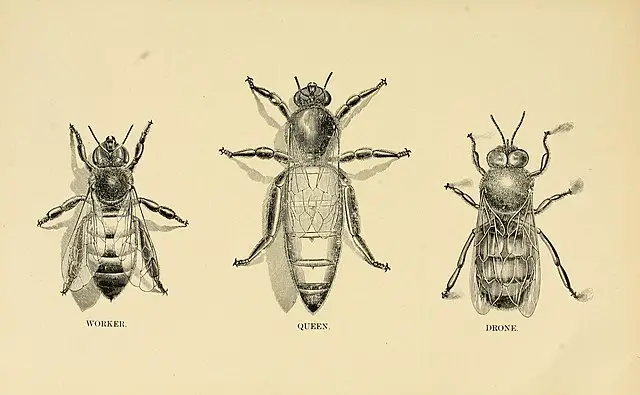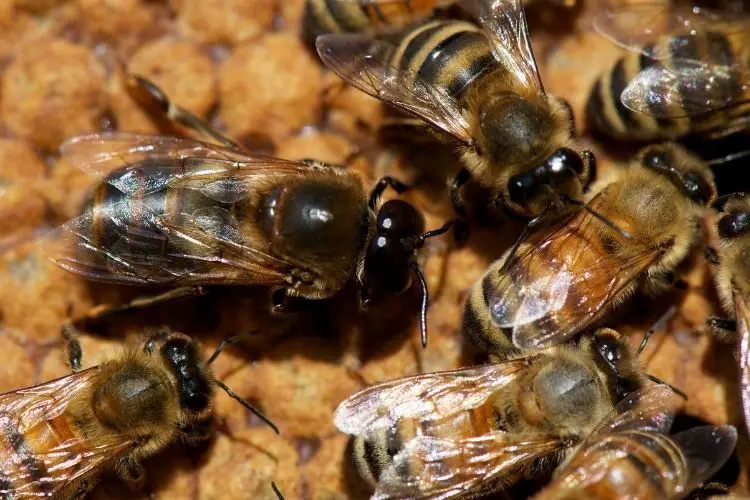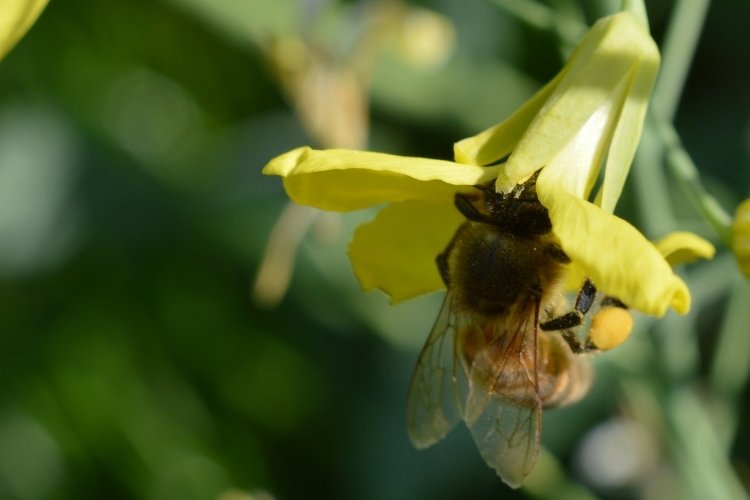Drones (male honey bees) and workers (female honey bees) are the most common castes inside a beehive. The only other type of bee inside the hive is the queen (and there is only one of her).
Drones and workers may look similar at first glance, but they have a number of key differences. Drones are larger than workers, have bigger eyes and stronger wings. These attributes help them perform their only role – finding and mating with a queen.
Worker bees, however, are smaller than drones – and their bodies are designed to perform a wide variety of tasks inside the hive.
Here are the ten main differences between drones and worker bees:
1. Drones are larger than workers
The most noticeable difference between a drone and a worker bee is their size. Drones are longer and wider than workers, and their shape is more like a barrel, whereas a worker’s abdomen is more pointed.
A worker is typically between 10-15mm long (0.4-0.6 inches). If you compare them to a drone from the same hive, the drone will usually be an extra 5mm (0.2 inches) or so in length. Drones are also a couple of millimeters (0.1 of an inch) wider than workers.
Drones have larger heads than worker bees too, that are rounder in shape. A worker’s head is smaller and more angular than a drone’s.

2. Drones have more powerful wings than workers
Drones have a larger thorax than worker bees. This is to facilitate their more developed wings.
Drones spend the majority of their lives flying back and forth between drone congregation areas, searching for a queen to mate with. If they weren’t powerful fliers, they wouldn’t be able to catch a queen in the air and mate with her.
3. Drones have bigger eyes than workers
If you only have one bee in front of you and want to tell whether it’s a drone or a worker, look closely at the eyes. All bees have five eyes – two big ones called compound eyes and three tiny ones called ocelli. However, drones have much larger compound eyes than workers.
A worker bee’s compound eyes sit on either side of their head. Drones, on the other hand, have huge compound eyes that sit on the top of their head, and are so large that they touch each other.
Drones need bigger eyes because they have to find a queen mid-flight in order to mate with her. Needless to say, this is a difficult task.

4. Drones have no stinger (workers do)
Only female bees have a stinger. A stinger is actually a modified ovipositor, which serves as both a weapon and an apparatus that helps to lay and position eggs.
Worker bees use the stinger to defend the hive from predators, such as bears, skunks and mice. A venom sac is attached to the stinger. Because the stinger is barbed, it becomes lodged inside the skin of the victim, and tears out the venom sac from the bee’s abdomen. That’s why worker bees die when they sting.
Drones don’t have stingers, because they are not female. They have no need for one to position eggs, and they don’t play a role in guarding the hive either, so they don’t need one as a weapon.
5. Drones have smaller mandibles than workers
The mandibles, or jaws, are different in worker bees and drones. Workers need strong mandibles, and use them from the start of their lives when they chew their way out of the cell they are born in.
Worker bees also use their mandibles for a variety of vital tasks inside the hive – feeding larvae, turning wax scales into drawn comb, grooming themselves and the queen, removing debris from the hive, and many more.
Drones have much smaller mandibles than workers, and they have jagged edges to help with cutting and biting. A worker’s mandibles are smooth, which makes it easier for them to produce wax and feed larvae.
Drones don’t need mandibles as strong as workers, because they aren’t charged with the tasks that worker bees are. Because they don’t have strong jaws, the capping of a drone cell is actually thinner than the cell a worker is born in. Often drones need help from workers to chew through the cell wall and emerge.
6. Drones have a shorter proboscis than workers
All bees have a proboscis, which is a straw-like tongue. However, worker bees have a longer and more complex proboscis than drones.
This is because workers use their proboscis to collect nectar from flowers. As such, it needs to be long and flexible enough to suck up nectar from those hard-to-reach parts of a flower.
Drones, however, don’t need their proboscis to forage for nectar, so it is shorter than that of a worker, and doesn’t possess the same degree of maneuverability.

7. Drones don’t have pollen baskets on their legs (unlike workers)
Worker honey bees have pollen baskets or corbiculae, which are a part of the tibia on their hind legs.
As workers move from one flower to another, they collect pollen on the hairs of their body. They use their proboscis to moisten their forelegs, then brush the pollen that has been collected on their body into the pollen baskets on their hind legs.
Drones don’t have pollen baskets, because they don’t forage for pollen.

8. Drones have different reproductive organs
Worker bees have female reproductive organs, while drones have male reproductive organs. Obviously, both are needed to ensure the survival of the species.
Worker bees do not have a fully developed spermatheca or ovaries (unlike queens), so they aren’t capable of storing the sperm needed to fertilize eggs.
After mating with a queen, a drone’s insides are ripped out, causing it to fall to the ground and die immediately after.
9. Drones come from unfertilized eggs; workers come from fertilized eggs
A queen bee lays two types of eggs – fertilized and unfertilized. Fertilized eggs develop into either worker bees or queens, depending on the diet they are fed. Unfertilized eggs develop into drones.
In some cases, if a queen dies suddenly and there are no suitable larvae to raise as a replacement, worker bees will start laying eggs. However, they’re not capable of laying fertilized eggs, because they never mate with drones, so every egg a worker lays becomes a drone. This is a disastrous occurrence for the colony, as they need worker bees to survive.
10. Drones don’t do any work
Worker bees get their names from the fact they do just that – work. They are responsible for so many vital tasks inside the hive, including:
- Collecting pollen and nectar
- Taking care of the brood
- Turning wax into drawn comb
- Feeding, grooming and cleaning the queen
- Keeping the hive clean
- Guarding the hive against predators and robber bees
- Making and storing honey
- Feeding drone bees
Drones, on the other hand, have one primary role – mate with the queen. Apart from that, drones do practically nothing. They spend their life flying to and from drone congregation areas in search of a queen. When they aren’t doing this, they just sit inside the hive and eat (something they need workers to help them with).
If a drone fails to mate with a queen and is still alive when winter approaches, workers will actually kick them out of the hive and leave them to die. This is because drones are a drain on resources, and don’t do anything to help the colony survive the winter. Their only purpose is to mate with queens, and queens don’t mate in the winter, so drones aren’t needed.
Summing Up…
Drones and workers are different – not just in appearance, but also in the role they play in the hive. It might sound like workers are much more important than drones, because they perform many more vital tasks. However, a drone’s job is also critical to the species because, without them, bees would not be able to reproduce.
